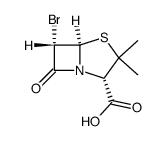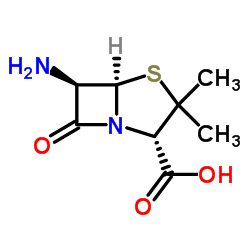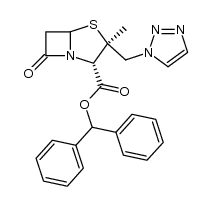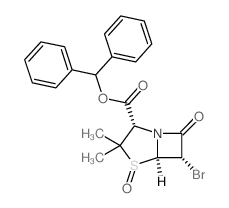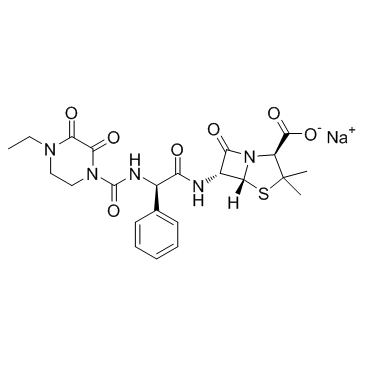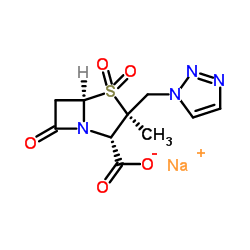89786-04-9
| Name | tazobactam |
|---|---|
| Synonyms |
MFCD00867002
YTR 830H Tazobactam [2S-(2a,3b,5a)]-3-Methyl-7-oxo-3-(1H-1,2,3-triazol-1-ylmethyl)-4-thia-1-azabicyclo[3.2.0]heptane-2-carboxylic acid 4,4-dioxide 4-Thia-1-azabicyclo[3.2.0]heptane-2-carboxylic acid, 3-methyl-7-oxo-3-(1H-1,2,3-triazol-1-ylmethyl)-, 4,4-dioxide, (2S,3S,5R)- T45 ANV ESWTJ F1 GVQ F1- AT5NNNJ &&(2S,3S,5R)- Form (2S,3S,5R)-3-Methyl-7-oxo-3-(1H-1,2,3-triazol-1-ylmethyl)-4-thia-1-azabicyclo[3.2.0]heptane-2-carboxylic acid 4,4-dioxide UNII-SE10G96M8W TAZOBACTANACID YTR-830H 2b-[(1,2,3-triazol-1-yl)methyl]-2a-methylpenam-3a-carboxylic acid 1,1-dioxide Tazobactan acid 2-METHANESULFONYL-5-(TRIFLUOROMETHYL)-1,3,4-THIADIAZOLE |
| Description | Tazobactam is a beta Lactamase Inhibitor with antibacterial activityTarget: AntibacterialTazobactam is a pharmaceutical drug that inhibits the action of bacterial β-lactamases, especially those belonging to the SHV-1 and TEM groups. It is commonly used as its sodium salt, Tazobactam sodium.Tazobactam is combined with the extended spectrum β-lactam antibiotic piperacillin in the drug piperacillin/Tazobactam, one of the preferred antibiotic treatments for nosocomial pneumonia caused by Pseudomonas aeruginosa. Tazobactam broadens the spectrum of piperacillin by making it effective against organisms that express β-lactamase and would normally degrade piperacillin. Tazobactam is derived from the penicillin nucleus and is a penicillinic acid sulfone. |
|---|---|
| Related Catalog |
| Density | 1.9±0.1 g/cm3 |
|---|---|
| Boiling Point | 707.1±70.0 °C at 760 mmHg |
| Melting Point | 172 °C(dec.) |
| Molecular Formula | C10H12N4O5S |
| Molecular Weight | 300.291 |
| Flash Point | 381.4±35.7 °C |
| Exact Mass | 300.052826 |
| PSA | 130.84000 |
| LogP | -1.70 |
| Vapour Pressure | 0.0±2.4 mmHg at 25°C |
| Index of Refraction | 1.818 |
| Storage condition | Store at?0-5°C |
CHEMICAL IDENTIFICATION
HEALTH HAZARD DATAACUTE TOXICITY DATA
|
| Hazard Codes | Xi: Irritant; |
|---|---|
| Risk Phrases | R36/37/38 |
| Safety Phrases | S26-S36/37/39-S45 |
| RIDADR | UN 1770 8/PG 2 |
| WGK Germany | 3 |
| Packaging Group | II |
| Hazard Class | 8 |
| HS Code | 29036990 |
|
~% 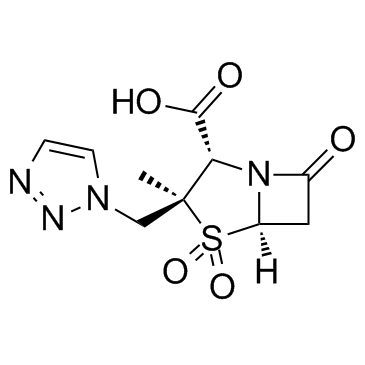
89786-04-9 |
| Literature: Synthesis, , # 3 art. no. F11904SS, p. 442 - 446 |
|
~% 
89786-04-9 |
| Literature: Synthesis, , # 3 art. no. F11904SS, p. 442 - 446 |
|
~% 
89786-04-9 |
| Literature: Synthesis, , # 3 art. no. F11904SS, p. 442 - 446 |
|
~% 
89786-04-9 |
| Literature: Synthesis, , # 3 art. no. F11904SS, p. 442 - 446 |
|
~% 
89786-04-9 |
| Literature: Synthesis, , # 3 art. no. F11904SS, p. 442 - 446 |
|
~% 
89786-04-9 |
| Literature: Synthesis, , # 3 art. no. F11904SS, p. 442 - 446 |
|
~% 
89786-04-9 |
| Literature: Synthesis, , # 3 art. no. F11904SS, p. 442 - 446 |
| Precursor 6 | |
|---|---|
| DownStream 2 | |
| HS Code | 29036990 |
|---|


